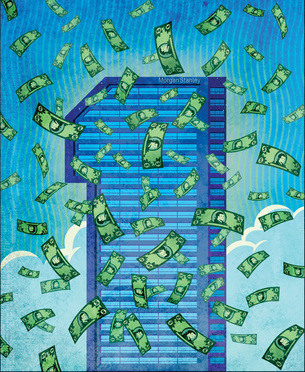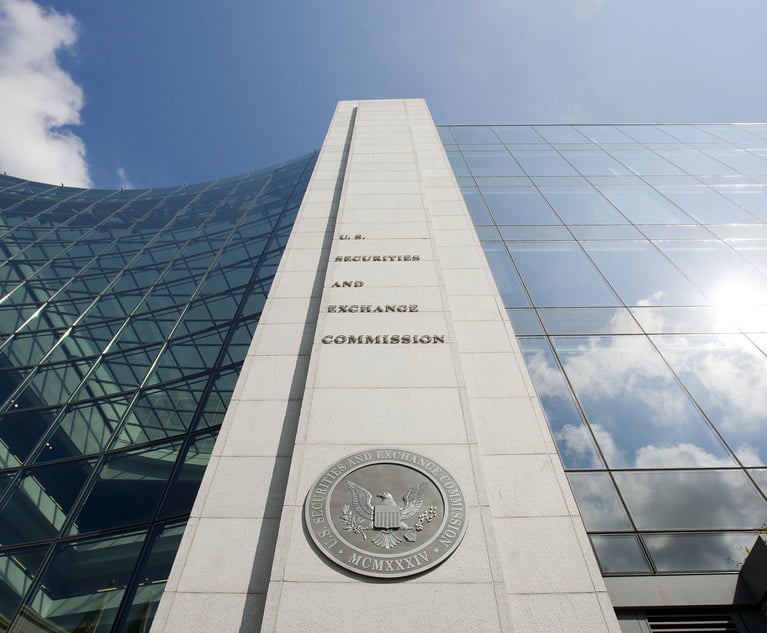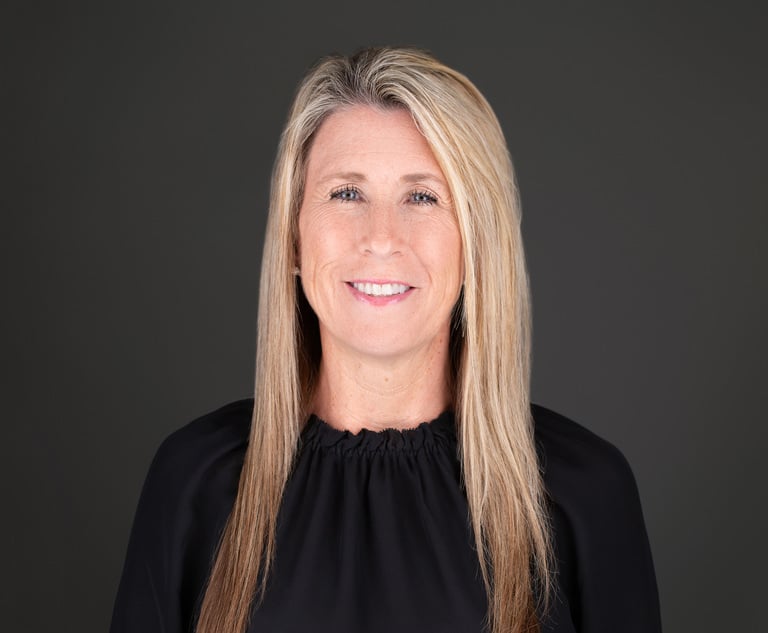The 2018 GC Compensation Survey: A New No. 1
Morgan Stanley CLO Eric Grossman debuts on our list in the top spot
August 01, 2018 at 07:00 AM
10 minute read

Talk about a big debut. This year, there's a new corporate legal boss on our GC compensation list—and he's shot right to the top of the charts.
According to our 2018 General Counsel Compensation Survey, Morgan Stanley chief legal officer Eric Grossman now reigns as the highest paid legal leader in the land—or at least the highest paid legal executive named in 2017 proxy filings. Last year, Grossman brought home total cash pay of $6,948,750. That breaks down to a $1 million salary and a cool $5,948,750 in bonus cash.
Of course not every in-house leader gets to be a compensation superstar like Grossman. There were mixed compensation results for GCs throughout the Fortune 1000, with gains in some metrics looking smaller than they did last year. There was also some indication that attorneys looking for compensation with a lot of room to grow shouldn't become top lawyers at the biggest companies.
But before diving deeper into the data, let's break down the survey methodology. Corporate Counsel affiliate ALM Legal Intelligence sifted through 2017 proxy filings from the Fortune 1000 to determine pay for companies' top legal officers. Not every company has its legal chief listed as a top executive in its filing—Grossman made Morgan Stanley's form for the first time in 2017, for instance—so not every top lawyer in the Fortune 1000 is accounted for in the survey.
The survey ranks GCs by total cash compensation, which is a combination of base salary, cash bonus and nonequity incentives (a form of pay made popular after the Dodd-Frank Act; it is discretionary and often performance-based).
ALM Legal Intelligence doesn't factor stock awards and options into the rankings but does collect data about this often significant piece of the executive compensation pie. The survey says that Grossman took home more than $3 million in stock awards in addition to his cash pay—that's not too shabby.
WINNING PAY
To achieve Morgan Stanley levels of cash compensation, it might help to become a GC in the finance industry. Alongside the entertainment industry, finance has led the pack in GC compensation for the past several years. And that makes sense, according to Todd Sirras, managing director of Semler Brossy, an executive compensation consulting group.
“GCs on the entertainment side are doing lots and lots of deals, and on the finance side they're dealing with a heavily regulated environment,” Sirras says. That extra regulatory work could explain why this year's No. 2 is also from the finance sector.
Laureen Seeger, GC of American Express Co., had total cash compensation of $6,718,385. Her base salary of $815,385 got even sweeter with an added $5,034,000 bonus and $869,000 in nonequity incentives. She also received nearly $2 million more in stock awards and options.
Unlike Grossman, Seeger's a comp list veteran—she's earned her way into our top five for the past three years. And she's had a steady rise, climbing up a spot from third place last year.
This year, the No.3 slot is filled by another perennial leader in our compensation surveys, Gerson Zweifach of Twenty-First Century Fox Inc. Zweifach actually had the highest base salary on the list with $3 million, and he got $2.5 million in nonequity incentives. He also earned $2,370,310 in stock awards.
The top two earners on our list either did not respond to requests for comment or declined comment for this story.
Fellow entertainment law leader (and potential future Zweifach colleague) Alan Braverman took fourth place on our 2018 list. While the Walt Disney Co. general counsel raked in an impressive cash total of $5,165,000 in 2017, that's more than $1 million less than his cash package in our previous survey. It wasn't enough to get Braverman to the top spot, where he reigned in 2015 and 2016.
New to the top five this year is Leucadia National Corp. GC Michael Sharp, with total cash compensation of $5 million. The food production industry GC bumped CBS Corp. GC Lawrence Tu out of the top five, down to No. 6.
Not yet in the top five but closing in are two of tech's best known in-house legal leaders—Microsoft Corp. chief legal officer Brad Smith and Netflix Inc. GC David Hyman. Sirras notes that as tech companies, especially Netflix, become more intertwined with the entertainment industry, more GCs in that field could see pay growth to match.
THE BIGGER PICTURE
But there's much more to our list than just GC rankings. Our survey also tracks year-over-year trends in pay metrics for the 100 GCs with the highest cash compensation. This year, the data revealed some positives and some negatives.
Let's start with the bad: average total cash compensation went down by 4.2 percent from last year's survey. Average cash compensation in this year's survey was $2,028,221, trailing behind last year's $2,117,469.
Total cash was dragged down by a 7.4 percent decrease in average nonequity incentives, from $1,201,865 in 2016 to $1,113,017 last year.
Before the panic sets in, here's some context: Last year's average included the $8,062,000 nonequity incentive cashout former Altria Group Inc. GC Denise Keane earned, a massive sum that comp experts tied to the fact she was retiring after more than 40 years at the tobacco company.
With Keane's go-out-with-a-bang compensation package removed, last year's average nonequity incentive was $1,124,415, making this year's drop in nonequity incentives and, therefore, in total cash, much less steep than it initially looks. Without Keane, total cash compensation still decreased, but only by 0.5 percent.
The good news is that, despite the dip in overall cash compensation, average salaries saw a boost of 2.5 percent, up to $717,183, and average bonuses rose 31.1 percent, to $1,472,965. It's worth noting that less than 20 percent of of the 341 legal leaders included in our survey reported a traditional bonus; the majority of GCs receiving extra cash got it in the form of nonequity incentives.
Sirras says the difference between receiving a bonus and nonequity incentives is only “what you call it.” So the small number of reported bonuses doesn't necessarily mean fewer people are getting extra cash—it just means that cash has a different name.
John Gilmore, co-founder and managing partner at consulting firm BarkerGilmore, says the slight drop in total compensation might be a sign of plateauing growth and change in larger legal departments, noting that the GCs on our list are from Fortune 1000 companies.
This year, GCs on our survey from the bottom half of the Fortune 1000 had an average cash compensation increase of 9.8 percent over those on last year's survey, while GCs from the top half of the Fortune 1000 saw less of a boost, just 2.0 percent.
“What we have seen is the larger companies did not perform as well and the bonuses will reflect that, but smaller and midsize companies tended to perform extremely well last year,” Gilmore says. “So at smaller and midsize companies, the percent increase [in cash compensation is] much higher than those at the larger companies.”
Gilmore theorizes that this difference in pay increases between GCs at midmarket companies and those at top could be due to a change in legal leaders' roles at smaller companies. While GCs at companies at the top of Fortune's list may have already had a seat at the business table for years, those at medium and small corporations may just be catching up now.
“At the midsize [companies], the GC is gaining a seat at the table, and they are being compensated for the increased responsibility,” Gilmore says. “The GCs of the larger companies have been a major component of the leadership team for a long time.”
When it comes to equity, some types are more popular than others. The average value of stock awards rose by 4.1 percent in this year's survey, while the the average value of stock options fell by 23.1 percent.
“It's part of a longer trend to move to full value shares and away from stock options,” Sirras said in an email. “It's been going on for seven [or] eight years, and now it's starting to stabilize. Options are good for driving stock price growth, but more companies are reducing or eliminating them and replacing with shares that are earned based on performance, either financial or shareholder return compared to peer companies or an index.”
This year, the top stock awardee in our survey was Kim Sinatra of Wynn Resorts, Limited, with a total of $10,815,000. AbbVie Inc.'s Laura Schumacher came in second with a total of $7,681,631.
PERSISTENT PAY GAP
The 2018 survey also reveals that, when it comes to cash compensation, women GCs have a way to go to achieve equity with their male counterparts.
Last year, only 24 percent of top paid GCs on our list were women. This year, that number budged very slightly to 25 percent. Among the top 100 best paid legal leaders, only 23 are women, fewer than 10 of whom are women of color.
And the number of women in the top 10 actually shrank from two to one this year, leaving American Express' Laureen Seeger as the only female in this group. “The biggest pay gap between women and men [in legal departments] happened at the GC level,” Gilmore says. He says that BarkerGilmore's 2018 In-House Counsel
Compensation Report found that female GCs were making around 78 percent of what male legal leaders were.
The gap between male and female GCs on our survey was narrower than that but still present. Average total cash earnings for female GCs in our rankings came out to about 95 percent of the average male pay. But with dollar amounts as high as these, that small difference adds up. The average woman's cash compensation on our compensation list was $1,147,793.10—more than $50,000 less than the average man's at $1,205,580.17.
That gap may be set to close. Gilmore says he's seen annual salaries increase for women GCs at a faster rate than men's salaries, and he's seen more companies focusing on including underrepresented groups of all kinds on their leadership teams.
Angela Beranek Brandt, president of the National Association of Women Lawyers, says that in-house lawyers have made some steps towards pay equity—though there's a long way to go. “In-house has made more progress in there being a higher percentage of female general counsel,” she says. “It stands to [reason] that the more women [who are] in higher positions, the smaller that pay gap is going to become. But it's a slow process.”
This content has been archived. It is available through our partners, LexisNexis® and Bloomberg Law.
To view this content, please continue to their sites.
Not a Lexis Subscriber?
Subscribe Now
Not a Bloomberg Law Subscriber?
Subscribe Now
NOT FOR REPRINT
© 2025 ALM Global, LLC, All Rights Reserved. Request academic re-use from www.copyright.com. All other uses, submit a request to [email protected]. For more information visit Asset & Logo Licensing.
You Might Like
View All
Ad Agency Legal Chief Scores $12M Golden Parachute in $13B Sale to Rival
3 minute read

From Reluctant Lawyer to Legal Trailblazer: Agiloft's GC on Redefining In-House Counsel With Innovation and Tech
7 minute readTrending Stories
Who Got The Work
J. Brugh Lower of Gibbons has entered an appearance for industrial equipment supplier Devco Corporation in a pending trademark infringement lawsuit. The suit, accusing the defendant of selling knock-off Graco products, was filed Dec. 18 in New Jersey District Court by Rivkin Radler on behalf of Graco Inc. and Graco Minnesota. The case, assigned to U.S. District Judge Zahid N. Quraishi, is 3:24-cv-11294, Graco Inc. et al v. Devco Corporation.
Who Got The Work
Rebecca Maller-Stein and Kent A. Yalowitz of Arnold & Porter Kaye Scholer have entered their appearances for Hanaco Venture Capital and its executives, Lior Prosor and David Frankel, in a pending securities lawsuit. The action, filed on Dec. 24 in New York Southern District Court by Zell, Aron & Co. on behalf of Goldeneye Advisors, accuses the defendants of negligently and fraudulently managing the plaintiff's $1 million investment. The case, assigned to U.S. District Judge Vernon S. Broderick, is 1:24-cv-09918, Goldeneye Advisors, LLC v. Hanaco Venture Capital, Ltd. et al.
Who Got The Work
Attorneys from A&O Shearman has stepped in as defense counsel for Toronto-Dominion Bank and other defendants in a pending securities class action. The suit, filed Dec. 11 in New York Southern District Court by Bleichmar Fonti & Auld, accuses the defendants of concealing the bank's 'pervasive' deficiencies in regards to its compliance with the Bank Secrecy Act and the quality of its anti-money laundering controls. The case, assigned to U.S. District Judge Arun Subramanian, is 1:24-cv-09445, Gonzalez v. The Toronto-Dominion Bank et al.
Who Got The Work
Crown Castle International, a Pennsylvania company providing shared communications infrastructure, has turned to Luke D. Wolf of Gordon Rees Scully Mansukhani to fend off a pending breach-of-contract lawsuit. The court action, filed Nov. 25 in Michigan Eastern District Court by Hooper Hathaway PC on behalf of The Town Residences LLC, accuses Crown Castle of failing to transfer approximately $30,000 in utility payments from T-Mobile in breach of a roof-top lease and assignment agreement. The case, assigned to U.S. District Judge Susan K. Declercq, is 2:24-cv-13131, The Town Residences LLC v. T-Mobile US, Inc. et al.
Who Got The Work
Wilfred P. Coronato and Daniel M. Schwartz of McCarter & English have stepped in as defense counsel to Electrolux Home Products Inc. in a pending product liability lawsuit. The court action, filed Nov. 26 in New York Eastern District Court by Poulos Lopiccolo PC and Nagel Rice LLP on behalf of David Stern, alleges that the defendant's refrigerators’ drawers and shelving repeatedly break and fall apart within months after purchase. The case, assigned to U.S. District Judge Joan M. Azrack, is 2:24-cv-08204, Stern v. Electrolux Home Products, Inc.
Featured Firms
Law Offices of Gary Martin Hays & Associates, P.C.
(470) 294-1674
Law Offices of Mark E. Salomone
(857) 444-6468
Smith & Hassler
(713) 739-1250







